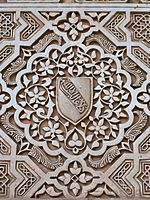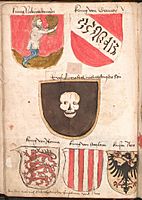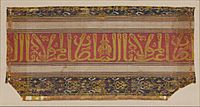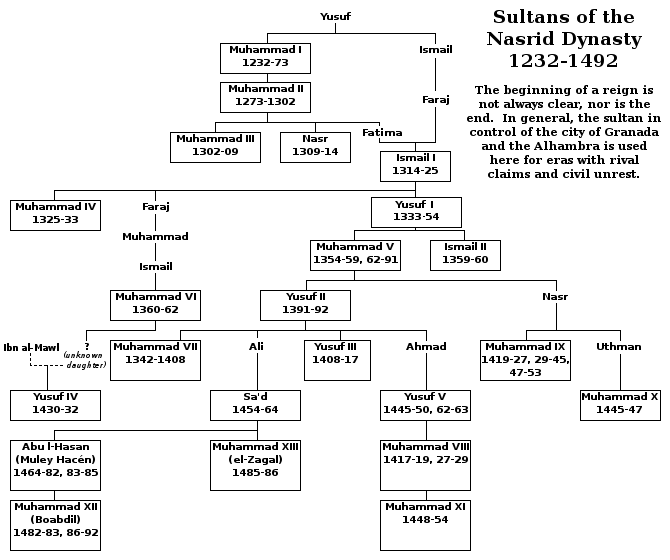Nasrid dynasty facts for kids
The Nasrid dynasty (pronounced Nah-srid) was a powerful Arab family that ruled the Emirate of Granada from 1230 to 1492. They were the very last Muslim rulers in the Iberian Peninsula, which is where modern-day Spain and Portugal are located.
Twenty-three different leaders, called emirs, ruled Granada during the Nasrid dynasty. Their rule began with Muhammad I of Granada in 1230. It ended on January 2, 1492, when the last ruler, Muhammad XII of Granada, gave up his lands to Queen Isabella I of Castile. Today, the most famous reminder of the Nasrid dynasty is the amazing Alhambra palace complex, which they built.
| Nasrid dynasty بنو نصر |
|||
|---|---|---|---|
| Country: | Quick facts for kids Emirate of Granada |
||
| Parent House: | Banu Khazraj | ||
| Founder: | Muhammad I of Granada | ||
| Final Ruler: | Muhammad XII of Granada | ||
| Founding Year: | 1230 | ||
Contents
The Rise of the Nasrid Dynasty
The Nasrid dynasty was founded by Muhammad I of Granada. Their kingdom included important cities like Granada, Jaén, Almería, and Málaga. Over time, Christian kingdoms in the north began to take back land. This period was known as the Reconquista.
Cities like Valencia and Játiva were conquered by Christian armies. Because of this, the Nasrids often had to pay tribute, or special payments, to the Christian rulers starting from 1243. This meant they were like vassals, or loyal subjects, to the Christian kings.
Even with these challenges, Granada remained a vibrant center of Islamic culture. The Nasrids also formed alliances with the Marinids, another powerful Muslim group from Morocco.
Amazing Art and Architecture
The Nasrid dynasty was famous for its beautiful crafts. They created stunning textiles and ceramic pottery, especially a type called lusterware. This pottery had a special shiny, metallic finish. It was first made in cities like Málaga and Murcia. By the 1400s, it was also made in Manises.
This unique style of pottery later influenced Italian ceramics, which became known as maiolica. The Nasrids were also well-known for their incredible palace architecture. The most famous example is the Alhambra palace in Granada. This amazing complex was built thanks to the efforts of rulers like Ismail I of Granada and Muhammad V of Granada.
-
This is the Coat of Arms of the Emirate of Granada, found on a wall inside the Alhambra palace.
The End of Nasrid Rule
In 1469, two powerful Christian rulers, Ferdinand II of Aragon and Isabella I of Castile, got married. This marriage united their kingdoms, Castile and Aragon. They then worked together to bring all of the Iberian Peninsula under Christian rule.
The last Nasrid ruler of Granada was Muhammad XII of Granada, also known as Boabdil. In 1492, he was sent away to Fez in Morocco. The remaining Muslim people in Granada were given a special status called mudéjar. This meant they could stay but had to follow Christian rule.
Family History
The Nasrid dynasty came from an Arab tribe called the Banu Khazraj. They believed they were direct descendants of Sa'd ibn Ubadah. He was an important chief of the tribe and a close friend, or companion, of the Islamic prophet Muhammad.
Challenges and Civil War
As the Christian kingdoms grew stronger, the Nasrid dynasty faced another big problem: a civil war within their own family. This was a fight over who should be the next ruler of Granada.
One ruler, Abu l-Hasan Ali, Sultan of Granada, was removed from power by his own son, Muhammad XII of Granada. Abu l-Hasan Ali then went to Málaga, and the civil war began. The Christian forces took advantage of this family fight. They continued to capture Muslim strongholds, or fortified towns.
In 1483, Muhammad XII was captured by Christian forces. He was set free after promising to be loyal to Ferdinand II of Aragon and Isabella I of Castile. Later, Abu l-Hasan Ali gave up his throne to his brother, Muhammad XIII, Sultan of Granada, who was known as Al-Zaghal. The power struggle with Muhammad XII continued.
Al-Zaghal won the family struggle but was eventually forced to surrender to the Christians. Muhammad XII was offered a lordship in the mountains, but he chose to take money from the Spanish crown instead and left the Iberian Peninsula.
Lasting Impact
The Nasrid dynasty was the longest-ruling Muslim dynasty in the Iberian Peninsula. They ruled for more than 250 years, from 1230 until 1492. Their most famous achievement is the construction of the incredible Alhambra palace-fortress complex in Granada. It stands today as a testament to their rich history and artistic skill.
Nasrid Rulers of Granada
The family tree below shows how the different Nasrid sultans were related. It starts with their common ancestor, Yusuf al-Ahmar. We've left out daughters and sons who never became rulers. When there were arguments about who should be sultan, this tree usually shows the sultan who controlled the city of Granada and the Alhambra palace.
See also
 In Spanish: Nazarí para niños
In Spanish: Nazarí para niños






